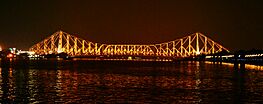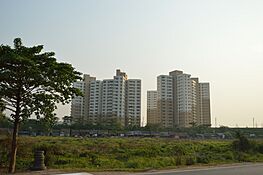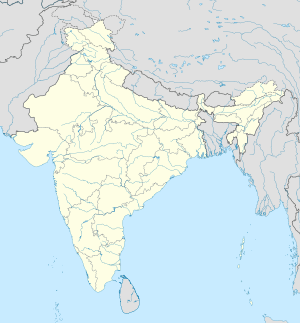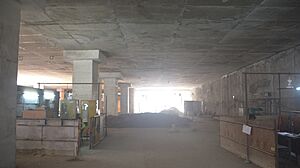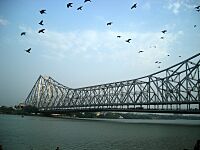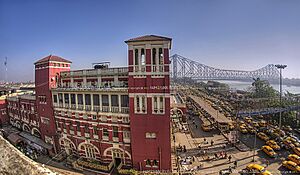Howrah facts for kids
Quick facts for kids
Howrah
|
|
|---|---|
|
The Howrah Bridge
Howrah Junction railway station, biggest (in terms of number of platforms), oldest and busiest railway station of India
Acharya Jagadish Chandra Bose Indian Botanic Garden at Shibpur
Inside IIEST Shibpur campus
Howrah Indoor Stadium at Dumurjala Sports City
High-rise apartments in Santragachi
|
|
| Nickname(s):
Sheffield of India
|
|
| State | |
| Division | Presidency |
| District | Howrah |
| Region | South Bengal |
| Government | |
| • Type | Municipal Corporation |
| • Body | Howrah Municipal Corporation |
| Area | |
| • Metropolis | 63.55 km2 (24.54 sq mi) |
| • Metro | 450.65 km2 (174.00 sq mi) |
| Elevation | 12 m (39 ft) |
| Population
(2011)
|
|
| • Metropolis | 1,077,075 |
| • Density | 16,948.5/km2 (43,896/sq mi) |
| • Metro | 2,811,344 |
| Languages | |
| • Official | Bengali |
| • Additional official | English |
| Time zone | UTC+5:30 (IST) |
| PIN |
711101 to 711114, 711201 to 711204 and 711302 and 711409
|
| Telephone code | +91 33 |
| Vehicle registration | WB-11 to WB-14 |
| Lok Sabha constituency | Howrah |
| Vidhan Sabha constituency | Howrah Uttar, Bally, Howrah Madhya, Howrah Dakshin, Shibpur |
Howrah (pronounced like "how-rah") is a big city in the Indian state of West Bengal. It sits on the western bank of the Hooghly River, right across from its twin city, Kolkata. Howrah is the main city in the Howrah district. It's famous for Howrah Junction railway station, which is one of India's largest and busiest train stations. This station connects Howrah to almost every part of India and is a major gateway to Kolkata.
Contents
What's in a Name?
The name Howrah comes from the Bengali word Haor. This word describes a swampy lake or a low-lying area where water, mud, and plants gather. This type of land was more common in eastern Bengal (now Bangladesh) than in western Bengal (where Howrah is).
Howrah's Past: A City's Journey
The city of Howrah has a history that goes back over 500 years. The area where the district is located was once part of an old Bengali kingdom called Bhurshut.
Early Mentions
Around 1578, an explorer from Venice named Cesare Federici wrote about a place called Buttor. He said large ships could sail there, suggesting it was a trading port. This place is thought to be the modern-day area of Bator. Bator was also mentioned in a Bengali poem from 1495.
British Rule and Growth
In 1713, the British East India Company wanted to gain control of five villages on the west bank of the Hooghly River. These villages included 'Harirah' (Howrah), 'Salica' (Salkia), and 'Battar' (Bator). By 1728, most of what is now Howrah district was part of two large land areas.
After the Battle of Plassey in 1760, the East India Company took over Howrah district. In 1843, Howrah district became separate from the Hooghly district.
People of Howrah
Howrah is the second most populated city in West Bengal, after Kolkata. In 2011, Howrah had over 1 million people living there.
Population Growth
Howrah's population grew very quickly in the late 1800s and early 1900s. This was because there were many job opportunities, which attracted a lot of people. For example, between 1896 and 1901, the number of men living in the city doubled!
| Year | Population | % increase | Males | Females |
|---|---|---|---|---|
| 1896 | 84,069 | |||
| 1901 | 157,594 | 99,904 | 57,690 | |
| 1911 | 179,006 | 13.59 | 114,566 | 64,440 |
| 1921 | 195,301 | 9.10 | 128,472 | 66,829 |
| 1931 | 224,873 | 15.14 | 145,120 | 79,753 |
| 1941 | 379,292 | 68.67 | 246,959 | 132,333 |
| 1951 | 433,630 | 14.33 | 268,412 | 165,218 |
| 1961 | 532,692 | 22.84 | 325,493 | 207,199 |
| 1971 | 737,877 | 38.52 | 439,457 | 298,420 |
| 1981 | 744,429 | 0.89 | 421,636 | 322,793 |
| 1991 | 950,435 | 27.67 | 528,396 | 422,039 |
| 2001 | 1,007,532 | 6.01 | 547,068 | 460,464 |
| 2011 | 1,077,075 | 6.90 | 561,220 | 515,855 |
Languages and Religions
Most people in Howrah speak Bengali. Other common languages include Hindi and Urdu.
| Religion in Howrah (2011) | ||||
|---|---|---|---|---|
| Religion | Percent | |||
| Hinduism | 82.72% | |||
| Islam | 15.25% | |||
| Jainism | 0.75% | |||
| Others | 1.28% | |||
Howrah's Climate
Howrah has a tropical wet-and-dry climate. This means it gets a lot of rain in the summers but very little in the winters. The average temperature is about 26.3°C, and it receives about 1744 mm of rain each year. Howrah is also known as one of India's "National Clean Air Cities."
| Climate data for Howrah, 1981–2010 | |||||||||||||
|---|---|---|---|---|---|---|---|---|---|---|---|---|---|
| Month | Jan | Feb | Mar | Apr | May | Jun | Jul | Aug | Sep | Oct | Nov | Dec | Year |
| Mean daily maximum °C (°F) | 25.8 (78.4) |
29.2 (84.6) |
33.5 (92.3) |
35.3 (95.5) |
35.3 (95.5) |
33.8 (92.8) |
32.4 (90.3) |
32.2 (90.0) |
32.4 (90.3) |
32.2 (90.0) |
30.1 (86.2) |
27.0 (80.6) |
31.6 (88.9) |
| Mean daily minimum °C (°F) | 14.1 (57.4) |
17.8 (64.0) |
22.4 (72.3) |
25.3 (77.5) |
26.4 (79.5) |
26.8 (80.2) |
26.5 (79.7) |
26.4 (79.5) |
26.0 (78.8) |
24.1 (75.4) |
19.7 (67.5) |
15.2 (59.4) |
22.6 (72.7) |
| Average precipitation mm (inches) | 10.4 (0.41) |
20.9 (0.82) |
35.2 (1.39) |
58.9 (2.32) |
133.1 (5.24) |
300.6 (11.83) |
396.0 (15.59) |
344.5 (13.56) |
318.0 (12.52) |
180.5 (7.11) |
35.1 (1.38) |
3.2 (0.13) |
1,836.4 (72.3) |
| Average rainy days | 1.1 | 1.7 | 2.2 | 3.4 | 7.0 | 12.8 | 17.7 | 16.9 | 13.9 | 7.4 | 1.3 | 0.5 | 85.9 |
| Source: India Meteorological Department | |||||||||||||
City Management
The Howrah Municipal Corporation manages the city of Howrah. The Howrah City Police is in charge of keeping law and order.
History of City Management

Howrah Municipality was started in 1862. In 1896, it began providing filtered water to the city. In 1984, Howrah became a municipal corporation, which is a bigger type of city government. The city is divided into 66 areas called wards, and each ward elects a representative.
City Development
Howrah is one of the biggest cities in its state. However, its growth has sometimes been unplanned. This has led to problems like traffic jams, a growing population, and pollution.
Recently, efforts have been made to improve the city. National Highways and local roads are being widened to help with traffic. There are also plans for new industrial projects. The West Bengal Government wants to make Howrah's city services as good as those in Kolkata.
Howrah's Economy
Howrah is often called the Sheffield of the East. This is because it's known for its engineering industry, especially light engineering. In 1823, a bishop named Reginald Heber said Howrah was a place "chiefly inhabited by shipbuilders." Today, there are many small engineering companies in Howrah.
Some big companies also have factories here. Burn Standard Company, which makes heavy machinery, has one of its oldest factories in Howrah. Shalimar Paints, established in 1902, had the first large paint factory in all of Southeast Asia located in Howrah.
Getting Around Howrah
Howrah has excellent connections by train, road, and even ferry services to Kolkata.
Train Travel
Howrah railway station is the main train station for Howrah and Kolkata. It's the second busiest train station in India and has the most platforms. It opened in 1854, connecting the city to coalfields. Howrah Station is a major hub, linking to most big cities across India. There are also twelve other train stations within Howrah city, like Santragachi and Shalimar.
Metro Rail
Howrah is connected to Kolkata by the Kolkata Metro Line 2. This metro line goes under the Hooghly River through a tunnel! The metro connects Howrah to Esplanade, where people can switch to other metro lines. The Howrah Station and Howrah Maidan metro stations are now open to the public.
Roads
Howrah has about 300 km (186 miles) of roads. The Grand Trunk Road, built by the British, starts near the Acharya Jagadish Chandra Bose Indian Botanic Garden in Howrah. Howrah also connects to major national highways, NH 16 and NH 19, through the Kona Expressway.
Bridges
Howrah and Kolkata are separated by the Hooghly River. Four bridges connect the two cities:
- Howrah Bridge, also called Rabindra Setu
- Vidyasagar Setu, also called the second Hooghly Bridge
- Vivekananda Setu, also called Bally Bridge
- Nivedita Setu, also called Second Bally Bridge
The Howrah Bridge and the Vidyasagar Setu are among the longest bridges of their kind in the world.
Other Ways to Travel
Ferry services have been available since the 1970s, connecting various points in Howrah and Kolkata across the river. Howrah is also served by Netaji Subhas Chandra Bose International Airport, which is located in Kolkata. Soon, the metro will connect Howrah directly to the airport.
Howrah's Neighbourhoods
Howrah has many different neighbourhoods. Some of the most well-known include Shibpur, Santragachi, Belur, Salkia, Ramrajatala, Liluah, Howrah Maidan, and Bally.
- Shibpur is home to the Acharya Jagadish Chandra Bose Indian Botanic Garden, which has the famous the Great Banyan tree. The Avani Riverside Mall is also here, along with the Indian Institute of Engineering Science and Technology, Shibpur.
- Santragachi has a large railway station and a big lake called Santragachhi Jheel, where many birds come in winter.
- Belur is where you'll find Belur Math, the main center of the Ramakrishna Math and Mission.
- Ramrajatala has a famous Rama Temple.
- Liluah has some of India's oldest railway factories and is also an important education hub in Howrah.
Education in Howrah
Howrah has many schools and colleges. The Indian Institute of Engineering Science and Technology, Shibpur is a public engineering and research university. It's one of the oldest engineering schools in India.
Schools in Howrah are run by the state government or by private groups. Students can study in Bengali, English, or Hindi. Schools follow different education boards, like the West Bengal Board or national boards like ICSE and CBSE.
Howrah Zilla School, started in 1845, is the only government school in Howrah. The first Bengali-medium school, Santragachi Minor School, opened in 1857. It's now known as Santragachi Kedarnath Institution, Howrah.
Sports in Howrah
Howrah has several places for sports. The Sailen Manna Stadium (also called Howrah Municipal Corporation Stadium) is used for football and other sports. Dumurjala Sports City is a big sports complex. The Howrah Rifle Club is a place for sports shooting.
Notable People from Howrah
Images for kids
See also
 In Spanish: Howrah para niños
In Spanish: Howrah para niños


